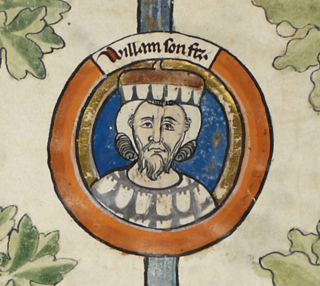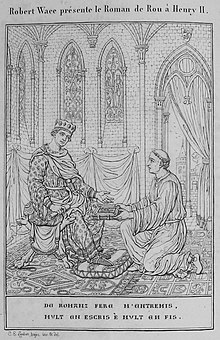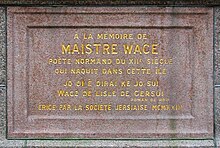
Rollo was a Viking who, as Count of Rouen, became the first ruler of Normandy, a region in today's northern France. He emerged as a leading warrior figure among the Norsemen who had secured a permanent foothold on Frankish soil in the valley of the lower Seine after the Siege of Chartres in 911. Charles the Simple, king of West Francia, granted them lands between the mouth of the Seine and what is now Rouen in exchange for Rollo agreeing to end his brigandage, swearing allegiance to him, religious conversion and a pledge to defend the Seine's estuary from other Viking raiders.

Wace, sometimes referred to as Robert Wace, was a Medieval Norman poet, who was born in Jersey and brought up in mainland Normandy, ending his career as Canon of Bayeux.
William of Poitiers was a Norman priest who served as the chaplain of Duke William II of Normandy, for whom he chronicled the Norman conquest of England in his Gesta Willelmi ducis Normannorum et regis Anglorum. He had trained as a soldier before taking holy orders.

Robert I of Normandy, also known as Robert the Magnificent and by other names, was a Norman noble of the House of Normandy who ruled as duke of Normandy from 1027 until his death in 1035. He was the son of Duke Richard II; the brother of Duke Richard III, against whom he unsuccessfully revolted; and the father of Duke William who became the first Norman king of England after winning the Battle of Hastings in 1066. During his reign, Robert quarrelled with the church—including his uncle Robert, archbishop of Rouen—and meddled in the disorder in Flanders. He finally reconciled with his uncle and the church, restoring some property and undertaking a pilgrimage to Jerusalem, during which he died.

Orderic Vitalis was an English chronicler and Benedictine monk who wrote one of the great contemporary chronicles of 11th- and 12th-century Normandy and Anglo-Norman England. Working out of the Abbey of Saint-Evroul, he is credited with writing the Historia Ecclesiatica, a work detailing the history of Europe and the Mediterranean from the birth of Jesus Christ into his own age. The son of a cleric, he was of born into a noble family, claiming both English and Norman heritage. While he is known primarily for the Historia Ecclesiastica, he also was able to ascend to various positions within the church including that script master, librarian, and cantor. A prolific writer, he spoke on various topics in his writings both religious and secular. Modern historians view him as a reliable source.

The Duchy of Normandy grew out of the 911 Treaty of Saint-Clair-sur-Epte between King Charles III of West Francia and the Viking leader Rollo. The duchy was named for its inhabitants, the Normans.

Richard I, also known as Richard the Fearless, was the count of Rouen from 942 to 996. Dudo of Saint-Quentin, whom Richard commissioned to write the "De moribus et actis primorum Normanniae ducum", called him a dux. However, this use of the word may have been in the context of Richard's renowned leadership in war, and not as a reference to a title of nobility. Richard either introduced feudalism into Normandy or he greatly expanded it. By the end of his reign, the most important Norman landholders held their lands in feudal tenure.
Dudo, or Dudon, was a Picard historian, and dean of Saint-Quentin, where he was born about 965. Sent in 986 by Albert I, Count of Vermandois, on an errand to Richard I, Duke of Normandy, he succeeded in his mission, and, having made a very favorable impression at the Norman court, spent some years in that country. During a second stay in Normandy, Dudo wrote his history of the Normans, a task which Duke Richard had urged him to undertake. Very little else is known about his life, except that he died before 1043.
Benoît de Sainte-Maure was a 12th-century French poet, most probably from Sainte-Maure-de-Touraine near Tours, France. The Plantagenets' administrative center was located in Chinon, west of Tours.

Gesta Normannorum Ducum is a chronicle originally created by the monk William of Jumièges just before 1060. In 1070 William I had William of Jumièges extend the work to detail his rights to the throne of England. In later times, Orderic Vitalis and Robert of Torigni, extended the volumes to include history up until Henry I.

Robert of Torigni was a Norman monk, prior, abbot and twelfth-century chronicler.

William of Jumièges was a contemporary of the events of 1066, and one of the earliest writers on the subject of the Norman conquest of England. He is himself a shadowy figure, only known by his dedicatory letter to William the Conqueror as a monk of Jumièges. Since he also mentions that he was an eyewitness of some events from the reign of Duke Richard III (1026-7), it seems reasonable to assume that he was born some time about the year 1000. He probably entered the monastery during the first quarter of the eleventh century and received his education from Thierry de Mathonville. According to Orderic Vitalis, William's nickname was "Calculus". The meaning behind this nickname is unknown. His death, after 1070, is unrecorded. He was a Norman writing from a Norman point of view. Although only a monk with evidently no military training, he wrote with pride in the accomplishments of his people.

William Longsword was the second ruler of Normandy, from 927 until his assassination in 942.
Bernard the Dane is described by the tenth century ecclesiastical writer Dudo of Saint-Quentin as a 'warrior' of Rouen from 'Dacia', an ally and confidant of the first leaders of Normandy, political counsellor to Rollo's son William Longsword, and co-regent of the territory during the minority of his son and heir, Richard I of Normandy. In particular, Bernard is seen as being at the centre of events in the aftermath of the assassination of William Longsword.
Anslech or Anslec de Bricquebec played a major political role in the first days of the duchy of Normandy, though the sources on him are rather opaque.

Turstin fitz Rolf, also known as Turstin le Blanc and Tustein fitz Rou played a prominent role in the Norman conquest of England and is regarded as one of the few proven companions of William the Conqueror at the Battle of Hastings in 1066.
Sprota was an early 10th century woman of obscure origin who became wife 'in the Viking fashion' of William I, Duke of Normandy, by her becoming mother of his successor, Duke Richard I. After the death of William, she married a wealthy landowner, Esperleng, by him having another son, Norman nobleman Rodulf of Ivry.

Hamon Dentatus was a Norman baron who was killed while rebelling with other Norman barons against William II, Duke of Normandy at the Battle of Val-ès-Dunes. The epithet "Dentatus" or "Dens" was probably given to Hamon because he was born with teeth. Little is known about Hamon's life.
Lagmann mac Gofraid may have been an early eleventh-century ruler of the Kingdom of the Isles. He seems to have been a son of Gofraid mac Arailt, King of the Isles, and was likely a member of the Uí Ímair kindred. According to mediaeval sources, Lagmann was closely associated with Óláfr Haraldsson, a future King of Norway. According one source, both men lent assistance to Knútr, son of Sveinn Haraldsson, King of Denmark, although it is possible that this account actually refers to Óláfr's campaigning in England several years beforehand. Lagmann and Óláfr are also recorded to have assisted Richard II, Duke of Normandy. The two are specified to have not only ravaged lands in Brittany on behalf of Richard, but were tasked to counter Richard's opponent Odo II, Count of Chartres. Lagmann's activities on the Continent may have arisen as a result of being forced from the Isles following the death of his possible brother Ragnall mac Gofraid, King of the Isles in 1004 or 1005. Lagmann's son, Amlaíb, is recorded to have perished at the Battle of Clontarf in 1014. If Lagmann died at about this time as well, it could account for the record of Hákon Eiríksson assuming control of the Isles.
Taisson le Ancien, or Old Badger, was a close companion of William Longsword and played a major political role in the early days of the Duchy of Normandy.












